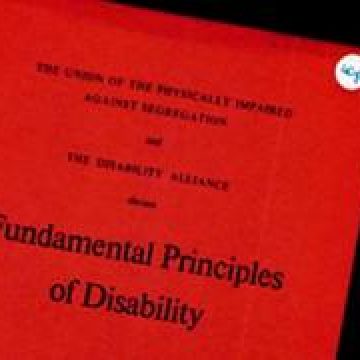In The Archive
We are pleased to show you some of the items in the Disabled People’s Archive, and we are proud to be the guardians of such a wealth of historical material.
The oldest items we are aware of so far are some photographs from the 1920s, and as history is constantly being created, the most recent are placards and documents from the Peterloo Memorial Access Campaign in 2019.
Only a fraction of the archive has been fully catalogued so far. Although we have detailed lists for some uncatalogued boxes, we only have a rough idea of what is in others. We are looking forward to exciting finds in the future when we can continue cataloguing, and will be delighted to share the archive with you, other disabled people, allies, researchers, students and academics.
We estimate there are over a million individual items in the archive. Some will be on their own, for example an information booklet, or a letter from one organisation to another about a specific topic. Others will be grouped together, such as a set of postcards, planning documents for an event, or series of meeting minutes.
Some items could go in more than one category. For example, a campaign badge could be an artefact because it is a made object, or ephemera because it was made for a specific time or place so is transitory (not made to last).
On the pages listed below you can explore different kinds of items from the archive. Where possible, we have provided a number of formats. Where that isn’t possible, we have tried to provide an alternative way of accessing the item.
Artefacts, ephemera and photographs have a little about the item, followed by a detailed image description. We have provided transcripts of the audio recordings featured. Some of the videos have closed captions or British Sign Language, others have a transcript. Documents are the most challenging in this respect. It is not always possible to modify an original document. Where we have a number of formats, we have provided them.
These are usually 3-D objects or ‘things’. In archiving terms artefacts are objects which have been made or modified by humans. When thinking of history people tend to think of items such as flint tools, coins and bowls or vases. But banners, placards, clothing, badges and more are also artefacts. Here we have photographs of artefacts with a little background information and a detailed visual description for each.
The archive has a collection of music and poetry. We share some of these here. We have included transcripts of the lyrics and poems.
We are using a broad meaning of document here. We include anything from an information booklet, meeting notes, newsletter or magazine, to an in-depth report. Where we have been able to find them, there are large print, easier to read and text only versions. We hope in the future to have audio of some documents too.
This is an odd word, but basically means anything that is not made to last for a long time (transitory), or that has a use for a limited time. Examples are letters, flyers, posters or leaflets for an event, campaign or period of time. We could include campaign badges, t-shirts and banners here, but we have chosen to include those in artefacts. There is background information about each item and a detailed visual description.
For the time being we are highlighting photographs from disabled people’s campaigns. Alongside the photograph you will find a little background information and a detailed visual description. If you recognise someone in a photo who we have not named, please do let us know!
Video covers a wide variety of film types. From short clips of home-made film at rallies, to programmes made by individuals and organisations. Or it could mean animations and films created as training tools. Here we have just a few. Please also see the Disabled People’s History page for some audio described, captioned and BSL interpreted short films about a few events in disabled people’s history.







